IT163M1 Effective Design Concepts: Relational Database Model
VerifiedAdded on 2023/06/10
|7
|1108
|399
Report
AI Summary
This report provides an overview of a relational database model designed for planning a family reunion. It begins with a research section explaining the fundamentals of relational databases, including their history, structure (tables, columns, rows, keys), and application using SQL. The report then presents a conceptual model for a family reunion database, focusing on the entities of 'Members' and 'Menu' and their respective attributes. Furthermore, the report elaborates on creating a logical model, including the normalization of tables to eliminate data redundancy and ensure data integrity, resulting in a relational schema with entities like 'Member,' 'Ingredients,' 'Meal,' and 'Menu,' complete with primary and foreign key relationships. The report concludes with a bibliography of cited sources.
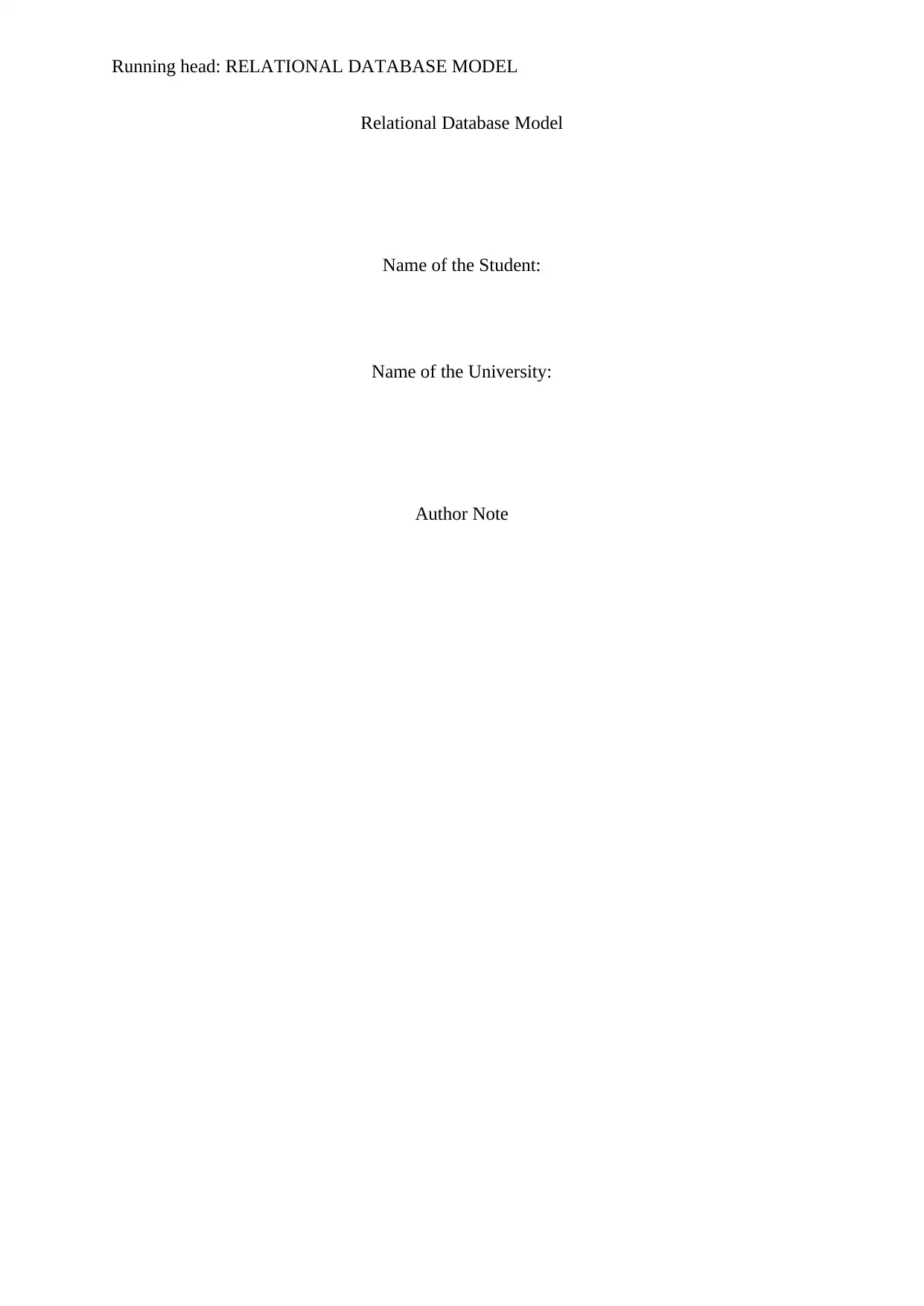
Running head: RELATIONAL DATABASE MODEL
Relational Database Model
Name of the Student:
Name of the University:
Author Note
Relational Database Model
Name of the Student:
Name of the University:
Author Note
Paraphrase This Document
Need a fresh take? Get an instant paraphrase of this document with our AI Paraphraser
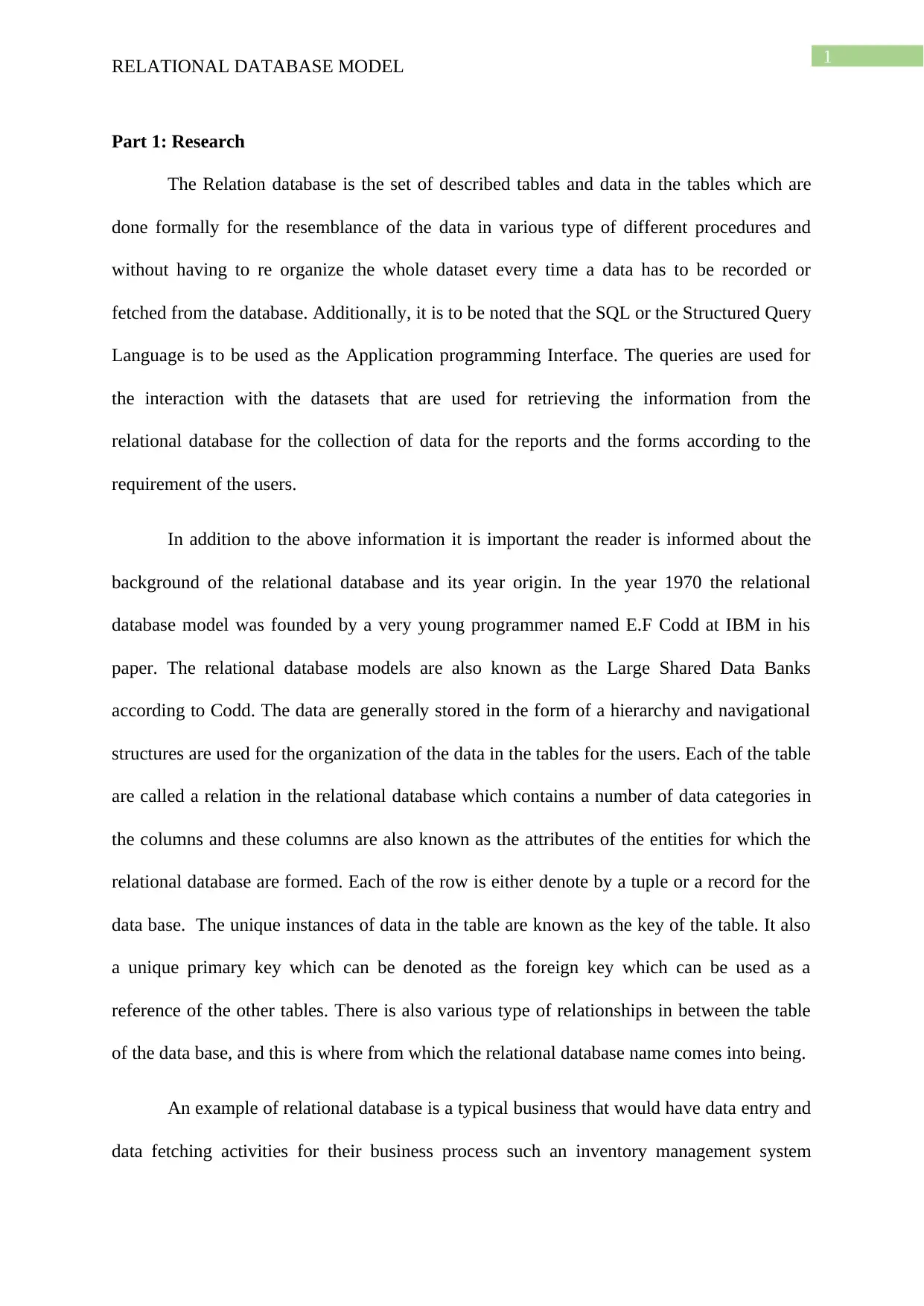
1
RELATIONAL DATABASE MODEL
Part 1: Research
The Relation database is the set of described tables and data in the tables which are
done formally for the resemblance of the data in various type of different procedures and
without having to re organize the whole dataset every time a data has to be recorded or
fetched from the database. Additionally, it is to be noted that the SQL or the Structured Query
Language is to be used as the Application programming Interface. The queries are used for
the interaction with the datasets that are used for retrieving the information from the
relational database for the collection of data for the reports and the forms according to the
requirement of the users.
In addition to the above information it is important the reader is informed about the
background of the relational database and its year origin. In the year 1970 the relational
database model was founded by a very young programmer named E.F Codd at IBM in his
paper. The relational database models are also known as the Large Shared Data Banks
according to Codd. The data are generally stored in the form of a hierarchy and navigational
structures are used for the organization of the data in the tables for the users. Each of the table
are called a relation in the relational database which contains a number of data categories in
the columns and these columns are also known as the attributes of the entities for which the
relational database are formed. Each of the row is either denote by a tuple or a record for the
data base. The unique instances of data in the table are known as the key of the table. It also
a unique primary key which can be denoted as the foreign key which can be used as a
reference of the other tables. There is also various type of relationships in between the table
of the data base, and this is where from which the relational database name comes into being.
An example of relational database is a typical business that would have data entry and
data fetching activities for their business process such an inventory management system
RELATIONAL DATABASE MODEL
Part 1: Research
The Relation database is the set of described tables and data in the tables which are
done formally for the resemblance of the data in various type of different procedures and
without having to re organize the whole dataset every time a data has to be recorded or
fetched from the database. Additionally, it is to be noted that the SQL or the Structured Query
Language is to be used as the Application programming Interface. The queries are used for
the interaction with the datasets that are used for retrieving the information from the
relational database for the collection of data for the reports and the forms according to the
requirement of the users.
In addition to the above information it is important the reader is informed about the
background of the relational database and its year origin. In the year 1970 the relational
database model was founded by a very young programmer named E.F Codd at IBM in his
paper. The relational database models are also known as the Large Shared Data Banks
according to Codd. The data are generally stored in the form of a hierarchy and navigational
structures are used for the organization of the data in the tables for the users. Each of the table
are called a relation in the relational database which contains a number of data categories in
the columns and these columns are also known as the attributes of the entities for which the
relational database are formed. Each of the row is either denote by a tuple or a record for the
data base. The unique instances of data in the table are known as the key of the table. It also
a unique primary key which can be denoted as the foreign key which can be used as a
reference of the other tables. There is also various type of relationships in between the table
of the data base, and this is where from which the relational database name comes into being.
An example of relational database is a typical business that would have data entry and
data fetching activities for their business process such an inventory management system
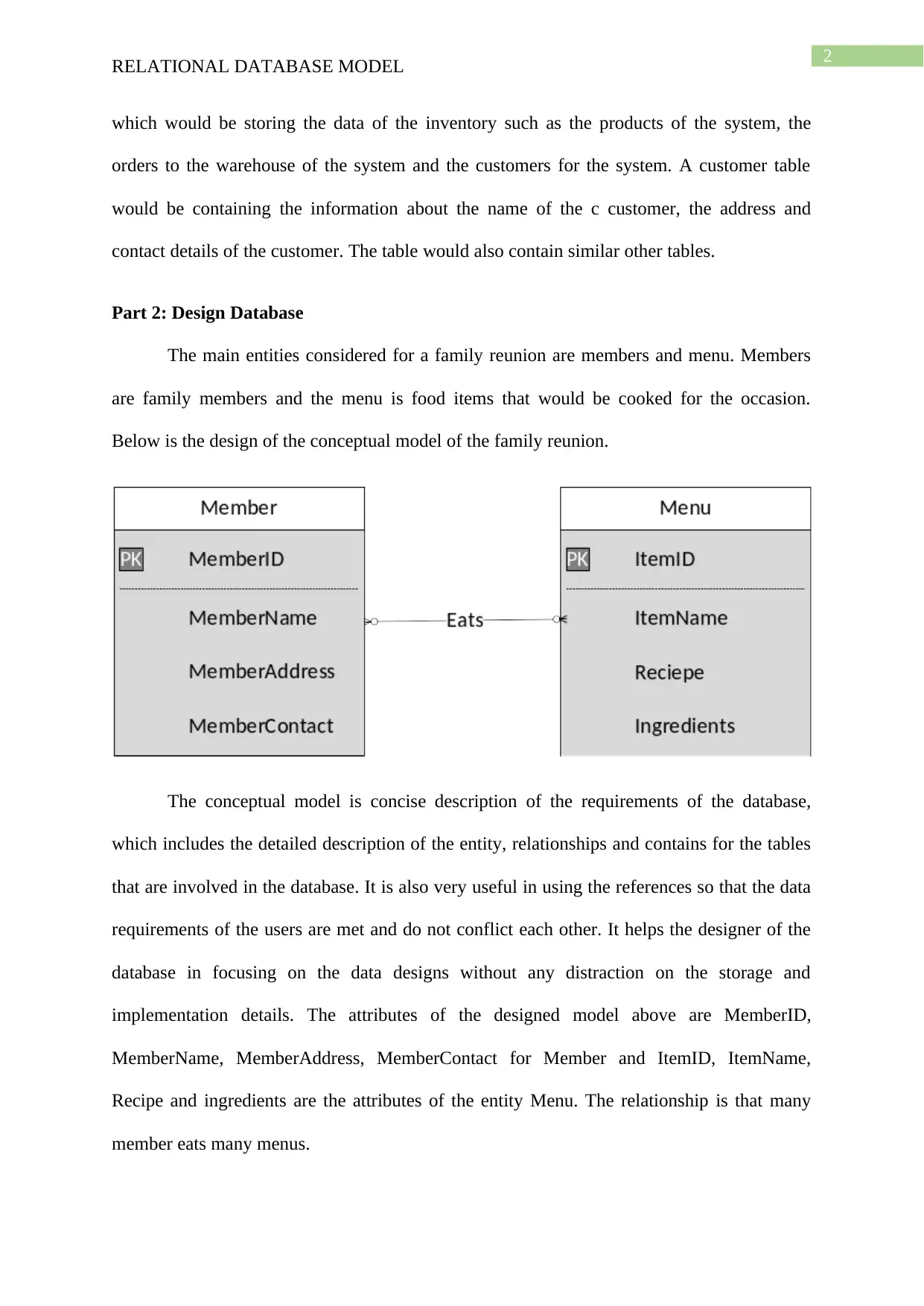
2
RELATIONAL DATABASE MODEL
which would be storing the data of the inventory such as the products of the system, the
orders to the warehouse of the system and the customers for the system. A customer table
would be containing the information about the name of the c customer, the address and
contact details of the customer. The table would also contain similar other tables.
Part 2: Design Database
The main entities considered for a family reunion are members and menu. Members
are family members and the menu is food items that would be cooked for the occasion.
Below is the design of the conceptual model of the family reunion.
The conceptual model is concise description of the requirements of the database,
which includes the detailed description of the entity, relationships and contains for the tables
that are involved in the database. It is also very useful in using the references so that the data
requirements of the users are met and do not conflict each other. It helps the designer of the
database in focusing on the data designs without any distraction on the storage and
implementation details. The attributes of the designed model above are MemberID,
MemberName, MemberAddress, MemberContact for Member and ItemID, ItemName,
Recipe and ingredients are the attributes of the entity Menu. The relationship is that many
member eats many menus.
RELATIONAL DATABASE MODEL
which would be storing the data of the inventory such as the products of the system, the
orders to the warehouse of the system and the customers for the system. A customer table
would be containing the information about the name of the c customer, the address and
contact details of the customer. The table would also contain similar other tables.
Part 2: Design Database
The main entities considered for a family reunion are members and menu. Members
are family members and the menu is food items that would be cooked for the occasion.
Below is the design of the conceptual model of the family reunion.
The conceptual model is concise description of the requirements of the database,
which includes the detailed description of the entity, relationships and contains for the tables
that are involved in the database. It is also very useful in using the references so that the data
requirements of the users are met and do not conflict each other. It helps the designer of the
database in focusing on the data designs without any distraction on the storage and
implementation details. The attributes of the designed model above are MemberID,
MemberName, MemberAddress, MemberContact for Member and ItemID, ItemName,
Recipe and ingredients are the attributes of the entity Menu. The relationship is that many
member eats many menus.
⊘ This is a preview!⊘
Do you want full access?
Subscribe today to unlock all pages.

Trusted by 1+ million students worldwide
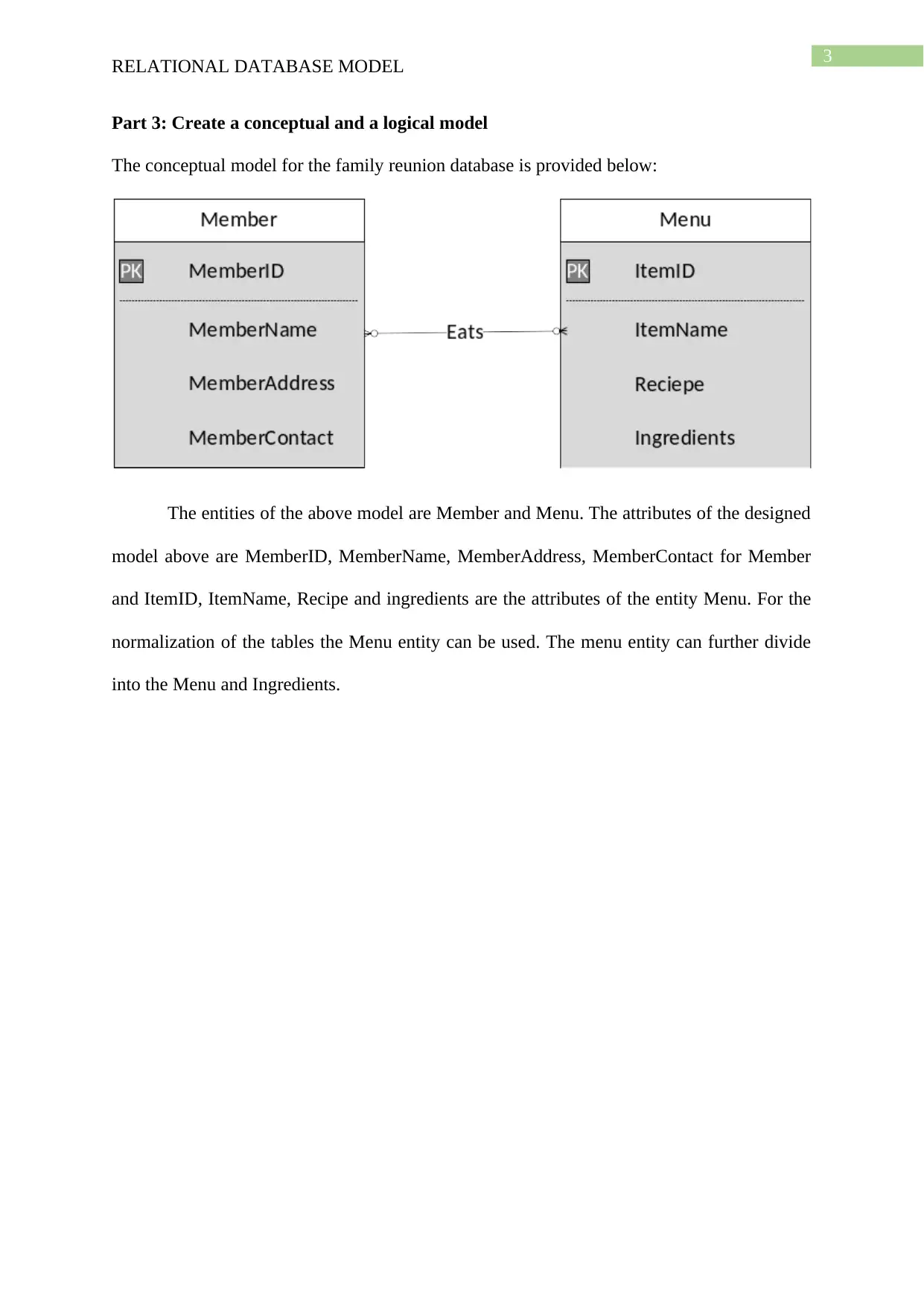
3
RELATIONAL DATABASE MODEL
Part 3: Create a conceptual and a logical model
The conceptual model for the family reunion database is provided below:
The entities of the above model are Member and Menu. The attributes of the designed
model above are MemberID, MemberName, MemberAddress, MemberContact for Member
and ItemID, ItemName, Recipe and ingredients are the attributes of the entity Menu. For the
normalization of the tables the Menu entity can be used. The menu entity can further divide
into the Menu and Ingredients.
RELATIONAL DATABASE MODEL
Part 3: Create a conceptual and a logical model
The conceptual model for the family reunion database is provided below:
The entities of the above model are Member and Menu. The attributes of the designed
model above are MemberID, MemberName, MemberAddress, MemberContact for Member
and ItemID, ItemName, Recipe and ingredients are the attributes of the entity Menu. For the
normalization of the tables the Menu entity can be used. The menu entity can further divide
into the Menu and Ingredients.
Paraphrase This Document
Need a fresh take? Get an instant paraphrase of this document with our AI Paraphraser
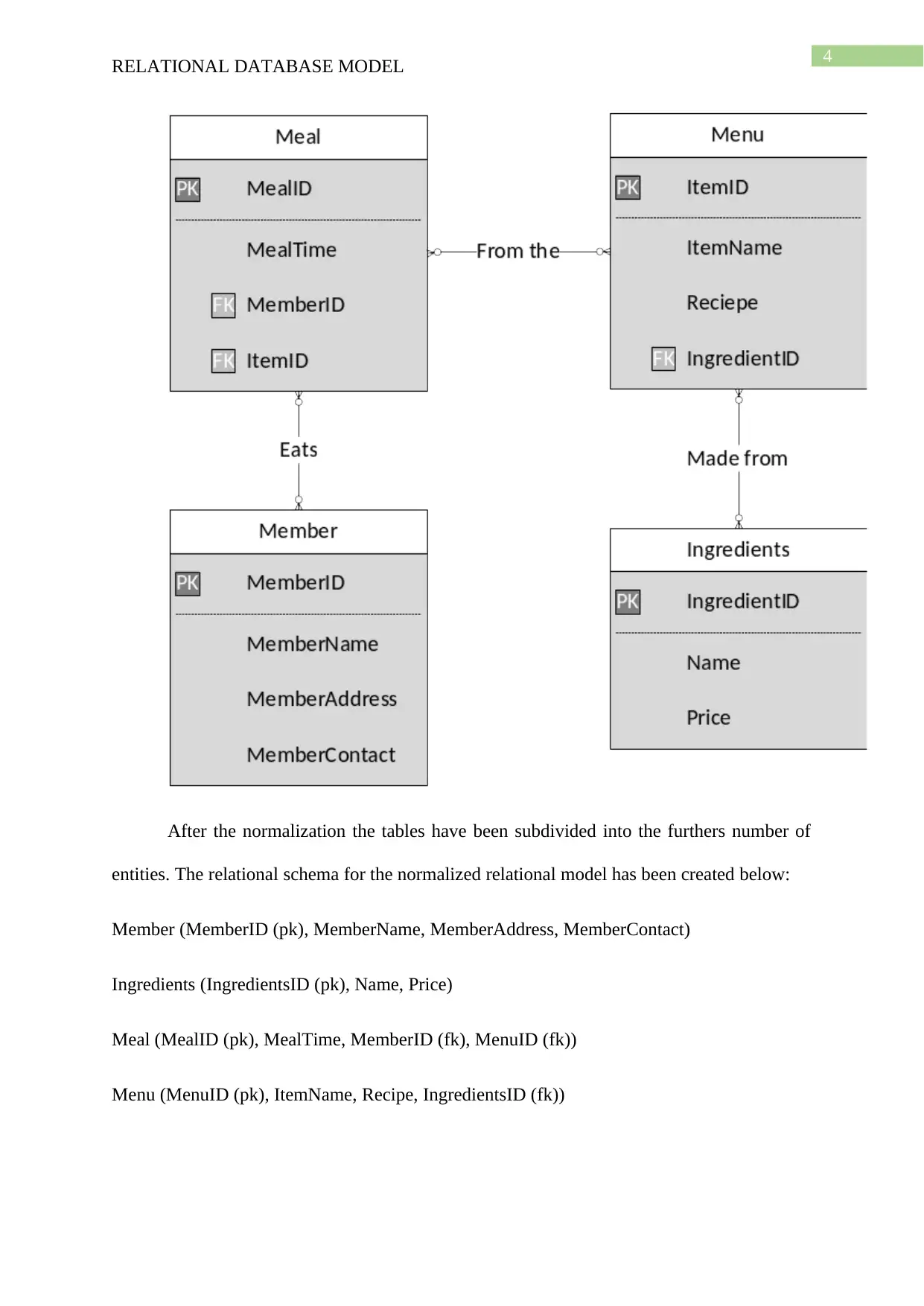
4
RELATIONAL DATABASE MODEL
After the normalization the tables have been subdivided into the furthers number of
entities. The relational schema for the normalized relational model has been created below:
Member (MemberID (pk), MemberName, MemberAddress, MemberContact)
Ingredients (IngredientsID (pk), Name, Price)
Meal (MealID (pk), MealTime, MemberID (fk), MenuID (fk))
Menu (MenuID (pk), ItemName, Recipe, IngredientsID (fk))
RELATIONAL DATABASE MODEL
After the normalization the tables have been subdivided into the furthers number of
entities. The relational schema for the normalized relational model has been created below:
Member (MemberID (pk), MemberName, MemberAddress, MemberContact)
Ingredients (IngredientsID (pk), Name, Price)
Meal (MealID (pk), MealTime, MemberID (fk), MenuID (fk))
Menu (MenuID (pk), ItemName, Recipe, IngredientsID (fk))

5
RELATIONAL DATABASE MODEL
For the normalization at first it is made sure that there are no data duplicity in the
database. After that it was seen that there are unique identities for each of the tuple which are
recorded in the database. In addition to the transitive dependencies were created for the
different tables were created so that it was ensured that the normalization was done
efficiently.
RELATIONAL DATABASE MODEL
For the normalization at first it is made sure that there are no data duplicity in the
database. After that it was seen that there are unique identities for each of the tuple which are
recorded in the database. In addition to the transitive dependencies were created for the
different tables were created so that it was ensured that the normalization was done
efficiently.
⊘ This is a preview!⊘
Do you want full access?
Subscribe today to unlock all pages.

Trusted by 1+ million students worldwide
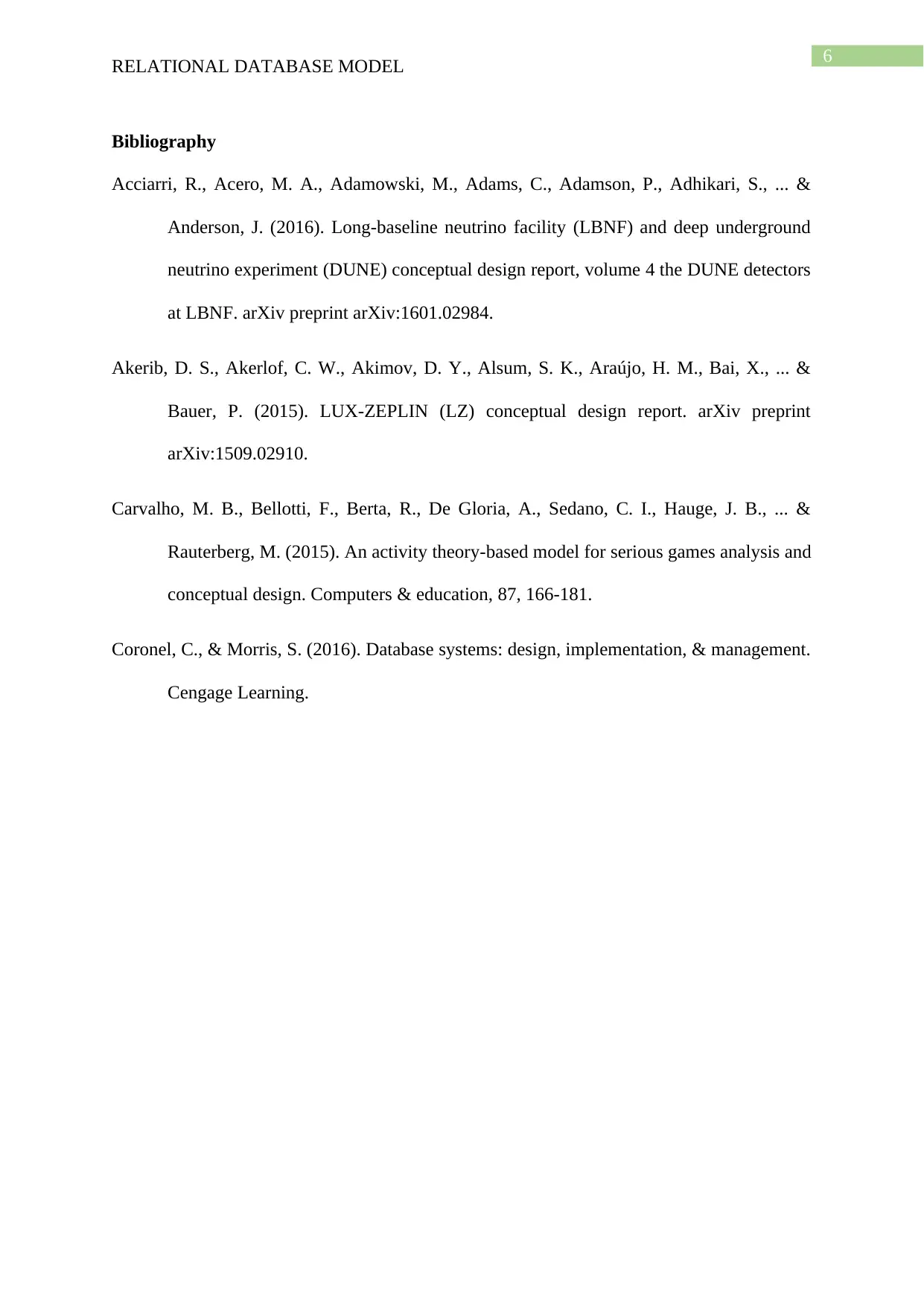
6
RELATIONAL DATABASE MODEL
Bibliography
Acciarri, R., Acero, M. A., Adamowski, M., Adams, C., Adamson, P., Adhikari, S., ... &
Anderson, J. (2016). Long-baseline neutrino facility (LBNF) and deep underground
neutrino experiment (DUNE) conceptual design report, volume 4 the DUNE detectors
at LBNF. arXiv preprint arXiv:1601.02984.
Akerib, D. S., Akerlof, C. W., Akimov, D. Y., Alsum, S. K., Araújo, H. M., Bai, X., ... &
Bauer, P. (2015). LUX-ZEPLIN (LZ) conceptual design report. arXiv preprint
arXiv:1509.02910.
Carvalho, M. B., Bellotti, F., Berta, R., De Gloria, A., Sedano, C. I., Hauge, J. B., ... &
Rauterberg, M. (2015). An activity theory-based model for serious games analysis and
conceptual design. Computers & education, 87, 166-181.
Coronel, C., & Morris, S. (2016). Database systems: design, implementation, & management.
Cengage Learning.
RELATIONAL DATABASE MODEL
Bibliography
Acciarri, R., Acero, M. A., Adamowski, M., Adams, C., Adamson, P., Adhikari, S., ... &
Anderson, J. (2016). Long-baseline neutrino facility (LBNF) and deep underground
neutrino experiment (DUNE) conceptual design report, volume 4 the DUNE detectors
at LBNF. arXiv preprint arXiv:1601.02984.
Akerib, D. S., Akerlof, C. W., Akimov, D. Y., Alsum, S. K., Araújo, H. M., Bai, X., ... &
Bauer, P. (2015). LUX-ZEPLIN (LZ) conceptual design report. arXiv preprint
arXiv:1509.02910.
Carvalho, M. B., Bellotti, F., Berta, R., De Gloria, A., Sedano, C. I., Hauge, J. B., ... &
Rauterberg, M. (2015). An activity theory-based model for serious games analysis and
conceptual design. Computers & education, 87, 166-181.
Coronel, C., & Morris, S. (2016). Database systems: design, implementation, & management.
Cengage Learning.
1 out of 7
Related Documents
Your All-in-One AI-Powered Toolkit for Academic Success.
+13062052269
info@desklib.com
Available 24*7 on WhatsApp / Email
![[object Object]](/_next/static/media/star-bottom.7253800d.svg)
Unlock your academic potential
Copyright © 2020–2025 A2Z Services. All Rights Reserved. Developed and managed by ZUCOL.





